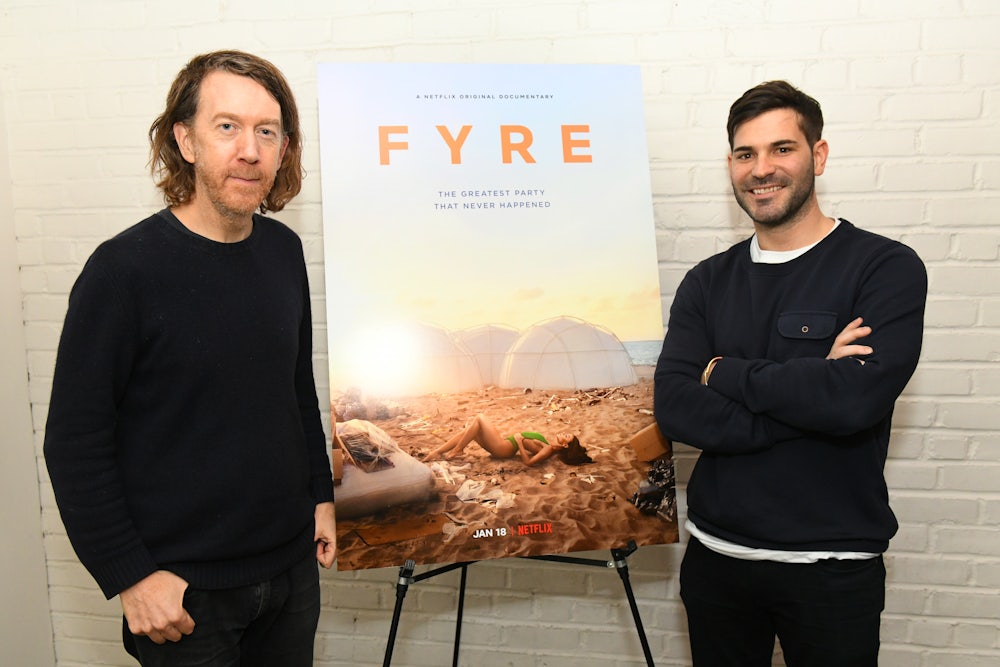When two movies come out on the
same topic, it’s a banner day for cultural criticism. The “twin film”
phenomenon—such as the recent Hollywood
treatments of the opioid crisis, Ben Is Back and Beautiful Boy—suggests
that a certain theme is resonating deeply with the public. It has a long
history: Oscar Wilde versus The Trials of Oscar Wilde in 1960, The Conversation versus The Parallax View in 1974, Armageddon versus Deep Impact in 1998. At the dawn of 2019, our twin film obsession
is Fyre Fraud versus Fyre, streaming on Hulu and Netflix, respectively. Both movies
seem to channel the spirit of the times, bedeviled by grifters and cheats, all
presided over by the occupant of the White House. But in the case of Netflix’s Fyre, the grift may have seeped into the
production of the film itself.
Both documentaries purport to tell the “real” story behind the Fyre Festival debacle of 2017, in which the charlatan Billy McFarland ripped off customers who had bought into an Instagram-fueled dream of partying with supermodels in the Bahamas. The dream never materialized—instead of champagne and concerts and luxury villas, ticket-holders encountered FEMA tents, empty beaches, and a transportation crisis. McFarland left behind a trail of unpaid debts, notably to the residents of Great Exuma itself, and ended up in jail for wire fraud.
The initial controversy surrounding the two documentaries centered on the timing of their release: The Hulu documentary was originally supposed to be a series, but was rushed into early release in feature-length form to beat Netflix to the punch. Then there were accusations from the Netflix camp that Hulu had behaved unethically by paying McFarland to appear in its documentary. Fyre director Chris Smith said, “After spending time with so many people who had such a negative impact on their lives from their experience on Fyre, it felt particularly wrong to us for him to be benefiting” from an interview payment.
Since that mudslinging episode, however, a new source of intrigue has emerged. The two movies ended up contextualizing their stories quite differently. Hulu’s Fyre Fraud focused on social media marketing agency FuckJerry—which is trying to rebrand as Jerry Media—and its complicity in McFarland’s doomed project. But Netflix’s Fyre was mysteriously quiet on that issue, instead highlighting eye-poppingly nefarious anecdotes, like event producer Andy King’s claim that he came very close to performing fellatio on a customs official to extract a detained shipment of Evian water.
Now, documents show that the CEO of FuckJerry, Mick Purzycki, who was a producer of Fyre, also claimed to have “final cut” over the documentary while it was being put together. Though his editing authority was later “superseded by the distribution agreement where the final cut was with the director,” according to Netflix, the way the movie was produced suggests that FuckJerry used the film to launder the troubled company’s reputation. And what appeared to be a story of competing films turns out to be something else: A genuine investigative documentary struggling for attention against a shadow public relations campaign.
The tale of the warring documentaries begins in May 2017, in the immediate aftermath of the Fyre Festival disaster. Neither documentary made this clear, but Billy McFarland himself started working on a “recovery documentary” as soon as Fyre Festival began to fall apart. He called on Michael Swaigen, a freelance cinematographer, to grab some onsite footage. Swaigen had shot the viral commercial for Fyre Festival that got the whole show rolling, as well as behind-the-scenes footage that is shown in the Netflix doc.
Swaigen is also an associate producer of Hulu’s Fyre Fraud and appears in that documentary: He’s the guy with the glasses and deadpan expression who wonders why everybody is so obsessed with Great Exuma. (“I guess it’s an island with a bunch of pigs,” he observes.) Some of his footage ended up in the Netflix movie because it was owned by his contractor at the time, Matte Projects, whose co-founder Brett Kincaid also co-produced Fyre.
As Fyre Festival melted down, McFarland told Swaigen, “We have to make a recovery documentary.” McFarland was “trying to save face,” Swaigen told me, “but that was probably secondary to trying to recoup money for investors, and he thought that a documentary was going to make a bunch of money.” Swaigen began to film with a documentary in mind.

At the same time, a Vice reporter named Gabrielle Bluestone was heading up the site’s reporting on Fyre Festival: the $250,000 payment to Kendall Jenner for a single Instagram post about Fyre Festival; the FEMA tents; and the payroll collapse that left Fyre Festival employees unpaid. After Swaigen returned to California from the “recovery” shoot, McFarland dropped out of contact, leaving him “screwed out of money,” he said, and wondering what to do with his footage. (McFarland would occasionally pop up to drop him small batches of money via Venmo, $500 here and there.) It was at this stage that Bluestone contacted him, saying some “heavy hitters” were interested in making a documentary, including Brendan Fitzgerald, who launched the Viceland cable channel (he eventually left the company).*
Vice flew Swaigen out to New York in October of 2017, where he met with Bluestone, Fitzgerald, and the award-winning filmmaker Chris Smith. According to a Netflix spokesman, it was Smith who had initially approached Vice with an idea for a documentary about Fyre Festival in August 2017. But Swaigen recalls asking Smith what he knew about Fyre Festival and discovering that Smith “knew absolutely nothing.” (Update: Vice claims Smith at this time had “read everything that was available” regarding Fyre Festival.) Swaigen was shown around the Vice offices—the microbrew beer taps, the floors of millennials at work—and Smith viewed some of his footage. Swaigen was wary of Vice’s flashy ethos, and left feeling dubious about the project.
At this point, Swaigen recalled, “there was no talk of FuckJerry” being involved in Vice’s film. It was FuckJerry that had hyped up the festival into an Instagram craze, using mysterious orange squares to tease its announcement. According to the Hulu documentary, FuckJerry was aware of the problems in the festival’s production, but proceeded full steam ahead anyway. A source from Vice explained that the Vice/Smith team collectively approached Jerry Media for footage in December 2017, which Netflix also confirmed.
After the Vice office visit, Swaigen returned to California, where he met with Ja Rule, the foremost celebrity involved in Fyre Festival, to find out his angle on the post-Fyre landscape. Ja Rule mentioned that Hulu was in talks to make a documentary. Swaigen emailed the filmmaker Jenner Furst a photograph of himself with McFarland, and Furst replied immediately. “It just felt better than anything that I had been through with [Vice],” Swaigen said.
The key difference between the Hulu project and the Vice project, Swaigen said, was that “it didn’t feel like anything shady.” At this point, Swaigen was “spying with integrity,” in his words, feeding information about the Vice documentary back to the other camp. In a statement, Cinemart, the company that produced Hulu’s Fyre Fraud, told me that “Michael was a big part of this story and his investigation during the aftermath of the festival was really insightful. We are grateful that Michael took everything into consideration when deciding who he would work with and that he ultimately chose to work with us.”
In January of 2018, Swaigen met with Mick Purzycki, who had been busy rebranding FuckJerry as a media “studio” through its subsidiary Jerry Media. The new studio’s first project was Fyre, which was FuckJerry’s first ever film production. Purzycki was by now a producer of the documentary; Swaigen speculates that he managed to finagle that role because Purzycki had direct knowledge of the Fyre debacle and could possibly negotiate an appearance from McFarland.
By February of 2018, Swaigen says, Bluestone and Fitzgerald had stopped talking to him. Furthermore, there was “no more talk of Vice” from director Chris Smith or Purzycki. Gabrielle Bluestone remains one of the documentary’s executive producers, but Purzycki told Swaigen that Vice was “kind of still involved in this peripheral sense, but Chris’s production company is running the team. And we’re Jerry Media now,” according to Swaigen.
After early screenings at Cannes in May 2018, Smith took Fyre to Netflix, which announced its acquisition of Fyre on December 10. Netflix said that the movie was directed by Smith, and that the executive producers were Elliot Tebele and James Ohliger from Jerry Media; Gabrielle Bluestone of Vice; and Max Pollack, Matthew Rowean, and Brett Kincaid of Matte Projects. So by the time of Netflix’s announcement, the producer list had become dominated by personnel from companies contracted directly by Fyre Festival: The show was run by Matte Projects (Swaigen’s employer, which owned most of the behind-the-scenes footage you see in Fyre) and Jerry Media itself. Although the Vice logo appears in the movie’s credits, the company seems to have been edged out.

FuckJerry has some serious answering to do related to its involvement in Fyre Festival. The company released a statement saying that “all actions taken by Jerry Media were done at the direction of the Fyre Festival,” suggesting that it was just as innocent as the scammed ticket-holders. But as several journalists have observed, none of the tickets would ever have been sold if it hadn’t been for FuckJerry’s efforts to spam social media with Fyre’s false advertisements. Furthermore, former FuckJerry employee Oren Aks has said that the company was aware of Fyre Festival’s problems far earlier than it has claimed, and therefore needs to be held accountable in Billy McFarland’s fraud.
Of course, Jerry Media denies such accusations.
But the accusations at least appeared in the Cinemart/Hulu documentary, which
has no vested interest in exonerating any parties involved; they did not appear in the Netflix documentary,
which was co-produced by the CEO of Jerry Media and several other FuckJerry
staffers, including its founder Elliot Tebele, who is now receiving an intense
backlash for plagiarizing other creatives’ content, led by the social media
hashtag #FuckFuckJerry. In fact, Fyre posits that the blame was solely McFarland’s. Those
facts alone are strong evidence that Fyre
is partially a cover-up, shot and edited to conceal FuckJerry’s mistakes
under garish anecdotes about blowjobs-for-Evian. Furthermore, in an
email to Michael Swaigen sent by Mick Purzycki dated March 25, 2018, he wrote: “I have final cut on the film and
will not be approving anything that is not done with integrity.”
Netflix disputed Purzycki’s “final cut” claim, telling me that “Jerry Media did not have final cut. There was an initial agreement that either party could walk away at any point and retain the rights to what they came into the project with. This was superseded by the distribution agreement where the final cut was with the director.” Purzycki confirmed that he sent the email to Swaigen, but that eventually “all production companies ultimately agreed that final cut belonged to the director and the distributor of the film.” (Purzycki also told me that McFarland was originally supposed to appear in the Netflix movie, according to a deal cut with Jerry Media for 12 percent of the film’s backend revenue to pay back ticket-holders, but he failed to show up at the last minute.** Vice confirmed the proposed arrangement, undermining Smith’s accusations of unethical behavior by Hulu.)
But whoever was in the room when that final cut was made, FuckJerry was still heavily involved. Purzycki has pivoted the old, tainted brand to video, dressing it up in the credibility of names like Netflix and Vice. These companies have been used, in effect, as the washing machine through which FuckJerry (and Matte, to some extent) laundered its involvement in a catastrophe.
Fyre Festival was the kind of international news flashpoint that encourages us to draw conclusions about the times we’re living in, but we’ve been failing to connect the dots between the festival and the coverage that has followed it. It’s scary to think about how Fyre Festival would have been portrayed if Hulu hadn’t rushed its movie out. The great thing about twin films is that, through different treatments, the competing accounts end up pointing the viewer toward the truth. Fyre Festival is a story about insidious digital marketing, corporate irresponsibility, and the misdeeds of a handful of men who control the images that appear on your social media and shape your opinions. They are doing it again, just under a different name.
*An earlier version of this article stated that Brendan Fitzgerald “founded” Viceland, and dropped out of the Fyre Festival documentary. He launched Viceland as its head of development, and left Vice altogether during the making of the documentary.
**An earlier version of this article stated that McFarland had reached an agreement with Jerry Media to appear in Fyre in exchange for revenue to pay McFarland’s debts. The agreement stipulated the revenue would pay back ticket-holders who had been scammed.
